
Straight Point is a coastal region, forming a headland, between Exmouth and Budleigh Salterton in Devon on the south coast of England.

Straight Point is a coastal region, forming a headland, between Exmouth and Budleigh Salterton in Devon on the south coast of England.
Straight Point is about 16 kilometres (9.9 mi) south of the city of Exeter, 4 kilometres (2.5 mi) southeast of Exmouth and about 11 kilometres (6.8 mi) southwest of Sidmouth.
The top of the headland is used by the Royal Marines as a firing range. To the west is Sandy Bay, a holiday beach, that can be reached either along the coastal path or through the large caravan park. To the east are Otter Cove and Littleton Cove.
The red sandstone cliffs at Straight Point show an interesting sequence of sandstones in the Exmouth Formation. Most of the western section is accessible at low tide from Sandy Bay. Only a small part of the eastern side is accessible at low tide. Predominantly the cliffs are composed of layers of "Aylesbeare Mudstone", but additionally with these sandstone Layers. These rock formations are important because they represent the earliest geology along the entire coast. They are from the Triassic period and date from 250 million years ago. Both sediments are markedly red, which indicates that they were formed in a desert.
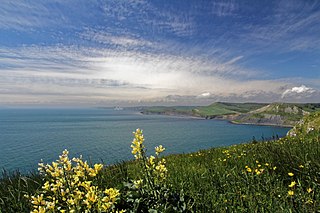
The Jurassic Coast is a World Heritage Site on the English Channel coast of southern England. It stretches from Exmouth in East Devon to Studland Bay in Dorset, a distance of about 96 miles (154 km), and was inscribed on the World Heritage List in mid-December 2001.

The South West Coast Path is England's longest waymarked long-distance footpath and a National Trail. It stretches for 630 miles (1,014 km), running from Minehead in Somerset, along the coasts of Devon and Cornwall, to Poole Harbour in Dorset. Because it rises and falls with every river mouth, it is also one of the more challenging trails. The total height climbed has been calculated to be 114,931 ft (35,031 m), almost four times the height of Mount Everest. It has been voted 'Britain's Best Walking route' twice in a row by readers of The Ramblers' Walk magazine, and regularly features in lists of the world's best walks.

Mount's Bay is a large, sweeping bay on the English Channel coast of Cornwall, United Kingdom, stretching from the Lizard Point to Gwennap Head. In the north of the bay, near Marazion, is St Michael's Mount; the origin of name of the bay. In summer, it is a large, benign, scenic, natural harbour. However, in winter, onshore gales present maritime risks, particularly for sailing ships. There are more than 150 known wrecks from the nineteenth century in the area. The eastern side of the bay centred around Marazion and St Michael's Mount was designated as a Marine Conservation Zone in January 2016.

Ringstead Bay and the small village of Ringstead are located on the coast in Dorset, southern England. The area lies on the Jurassic Coast and is known for its natural environment and fossils.

St Bees Head is a headland on the North West coast of the English county of Cumbria and is named after the nearby village of St Bees.
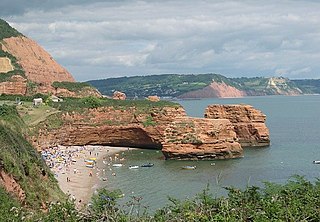
Ladram Bay is a secluded bay with a pebble beach, on the south coast of Devon, England between the coastal towns of Budleigh Salterton and Sidmouth. It is about 11 miles southeast of Exeter, just under 2 mi (3 km) southwest of Sidmouth and about 2+1⁄2 miles (4 km) northeast of Budleigh Salterton.
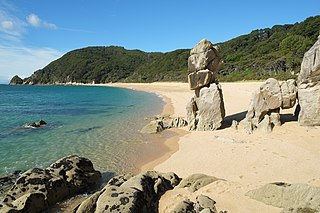
The Abel Tasman Coast Track is a 60 kilometres (37 mi) long walking track within the Abel Tasman National Park in New Zealand. It extends from Mārahau in the south to Wainui in the north, with many side tracks. It is one of two main tracks through the park, the other being the Abel Tasman Inland Track, which stretches for 38 km between Tinline Bay and Torrent Bay off the main coastal track. The coastal track is well sheltered, and with mild weather in all seasons, it is accessible and open throughout the year.

Orcombe Point is a coastal feature near Exmouth, Devon, on the south coast of England. It lies about 10 mi (16 km) south of the city of Exeter, 2 mi (3.2 km) southeast of Exmouth town centre and about 7.5 mi (12.1 km) southwest of Sidmouth.

Sandymouth is a beach three miles north of Bude in Cornwall, England, United Kingdom.

The East Coast Trail (ECT) is a long-distance coastal footpath located in the Canadian province of Newfoundland and Labrador. It is a developed trail over 336 kilometres (209 mi) long, creation of which began in 1994. It is made up of 25 linked wilderness paths and passes through more than 30 communities. It was named one of the best adventure destinations by National Geographic in 2012 and is extended and improved yearly.

Saltern Cove is a Site of Special Scientific Interest. It is on the coast of Tor Bay, south of Paignton, Devon, England. It is one of the coves which make up the local area known as "Three Beaches".

Achilles Point is a rocky point on the headland at the eastern end of the small sandy beach named Ladies Bay, Auckland, New Zealand. The name 'Te Pane o Horoiwi' can also sometimes refer to the whole headland between St Heliers and Tamaki River estuary. Achilles Point is named after a ship called HMNZS Achilles (70) which defeated the German pocket battleship Admiral Graf Spee in 1939. The headland, from the point round to the Tamaki heads, was previously known as Te Pane o Horoiwi, named after Horoiwi who arrived in New Zealand on the Tainui canoe (waka).

Pondfield Cove is a small, secluded, south-facing cove immediately to the east of Worbarrow Tout and west of Gad Cliff on the south coast of the Isle of Purbeck, in Dorset, England. It is about 12 kilometres (7.5 mi) south of Wareham and about 16 kilometres (10 mi) west of Swanage.

Caerfai Bay near St Davids in Pembrokeshire, West Wales has cliffs of purple sandstone and a sandy beach at low tide reached by steep steps. The beach is situated in the Pembrokeshire Coast National Park and on the Pembrokeshire Coast Path and has rugged coastal scenery with the path winding up and down the cliffs. There is free parking above the beach with picnic benches and views of the islands of Penpleidiau, Skomer and Skokholm.
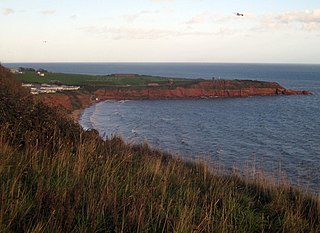
Sandy Bay is a secluded bay with a sand beach, about 1.6 kilometres (0.99 mi) long, in Exmouth, Devon, England. It is a sandy beach with rock pools at one end, backed by high cliffs. It is part of a long strip of sand which is connected to the beach at Exmouth at low tide. Nearby are the Orcombe rocks, which is a famous spot for fossils.

Danger Point is a coastal feature and cliff face in Devon, on the south coast of England. It is about 18 kilometres (11 mi) southeast of the city of Exeter and about 7 kilometres (4.3 mi) east of Exmouth and lies between the towns of Budleigh Salterton and Sidmouth.
Otter Cove is a small secluded cove on the south coast of Devon, England, between the coastal towns of Exmouth and Budleigh Salterton. It is part of the Jurassic Coast World Heritage Site. Due to a landslip the cove is no longer accessible from the headland.
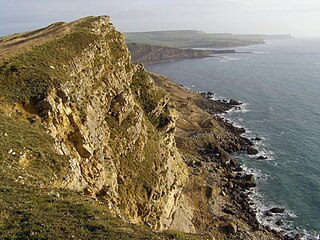
Gad Cliff is a south-facing cliff face, immediately to the east of Worbarrow Tout and Pondfield Cove, on the south coast of the Isle of Purbeck in Dorset, England. Behind it is Gold Down, part of the Lulworth Ranges.

Nepean Bay is a bay located on the north-east coast of Kangaroo Island in the Australian state of South Australia about 130 kilometres south-south-west of Adelaide. It was named by the British navigator, Matthew Flinders, after Sir Evan Nepean on 21 March 1802.
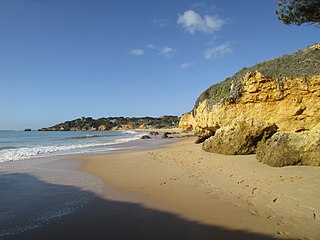
Praia da Balaia is a small satellite beach at the eastern end of its larger neighbour, Praia Santa Eulália, on the Atlantic south coast of the Algarve. Its is within the municipality of Albufeira and is 3.1 kilometres (1.9 mi) east of the town of Albufeira and 1.7 kilometres (1.1 mi) west of the coastal village of Olhos de Água.